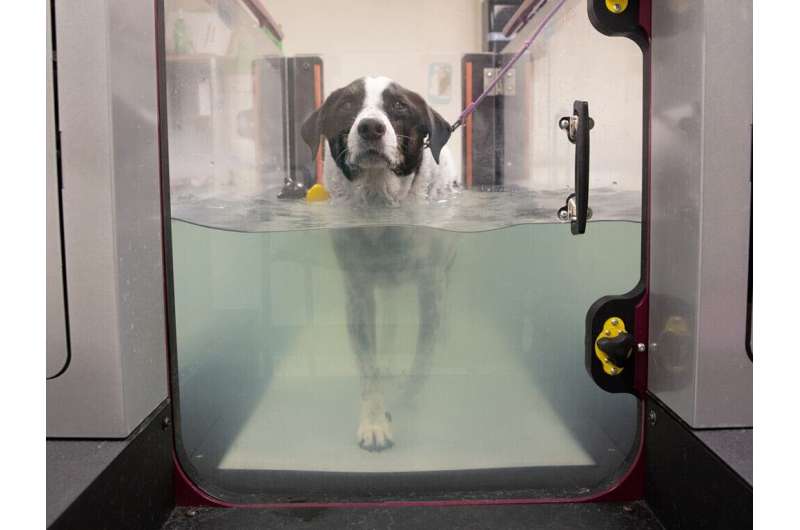This article has been reviewed according to Science X's editorial process and policies. Editors have highlighted the following attributes while ensuring the content's credibility:
fact-checked
trusted source
proofread
Exploring physical rehabilitation for dogs

When dogs have an injury or chronic condition, such as arthritis, physical rehabilitation can ease their pain and improve their strength and flexibility.
"There are a number of situations where dogs could benefit from physical rehabilitation, but the common reason is to improve recovery following surgery, usually orthopedic surgery—or surgery on bones and joints—and neurologic surgery—typically back or neck surgery," said Dr. Jacqueline Davidson, a clinical professor at the Texas A&M School of Veterinary Medicine and Biomedical Sciences. "Most programs will include specific strengthening or stretching exercises that are prescribed to target the primary muscles or tissues that are involved."
Other reasons that a dog could benefit from a rehabilitation program include recovering from injuries that did not require surgery, such as leg, foot or nerve injuries; increasing mobility and quality of life for obese or older patients; or improving a working or sporting dog's performance.
To support a patient's recovery, a certified veterinarian trained in rehabilitation is needed to design an appropriate exercise program based on a dog's concerns. If your veterinarian is not certified in rehabilitation, they can refer your dog to one who is.
"The most important aspect of a program is a veterinarian who has the knowledge and skill to develop and perform an effective treatment program," Davidson said. "The veterinarian prescribing the program will first do an assessment to determine specific issues and take measurements where possible. For example, they might measure muscle size before and after the therapy has begun to monitor for improvements and determine whether the program is effective."
Certified veterinarians may also recommend supplemental treatments, each with their own benefits, that can be added to the recovery program as well. Some common types, according to Davidson, include:
- Cold laser therapy: This non-invasive and drug-free treatment uses focused light to reduce inflammation and pain.
- Heat therapy: Heat is applied to affected joints that can reduce pain and increase flexibility.
- Electrical stimulation: Low-level electrical currents can be administered to reduce pain or strengthen muscles.
- Shock wave therapy: Using high-energy sound waves, this noninvasive treatment helps dogs relieve pain.
- Therapeutic ultrasound: Providing deep heat within tissues can reduce pain, increase flexibility and promote wound healing.
- Water treadmills: Depending on how a water treadmill is used, it can improve a dog's strength, joint motion and stamina. While water treadmills are a good addition to a rehabilitation program, Davidson explained that a large part of therapy involves exercises that can be done without water.
"It is possible that one or more of these treatments could be included, but many effective treatment programs include none of these treatments," Davidson explained. "Generally, the most important treatments are the various physical exercises that are prescribed after the evaluation of a dog."
Because treatment programs can vary, Davidson strongly recommends owners first visit with a certified veterinarian to discuss whether rehabilitation can improve their dog's quality of life.
"Owners can consult with their veterinarian about rehab if they feel their pet is not getting around as well as they used to, seems to be less active, or is favoring one leg," Davidson said. "Someone with training will be able to assess the various pros and cons for an individual patient and can recommend appropriate exercises, when to do them, and what the intensity level should be."
At home, owners can support their dog's recovery by walking them, as this can improve such daily activities as walking to their food dish or outside to pee.
"Walking is a fundamental activity in the daily lives of most dogs, so controlled walking is often a safe exercise that can be beneficial," Davidson said. "Nevertheless, it is sometimes difficult for owners to get their pets to do the exercises correctly, so it can help to have the rehabilitationist work with the owner and their pet to ensure that the exercises are being performed in a safe and effective manner."
Rehabilitation is a broad field that can include different programs and treatments specific to your furry friend's condition, so working with your veterinarian to determine the best course of action can provide the most rewarding outcomes: pain relief, comfort and improved well-being.
Provided by Texas A&M University





















